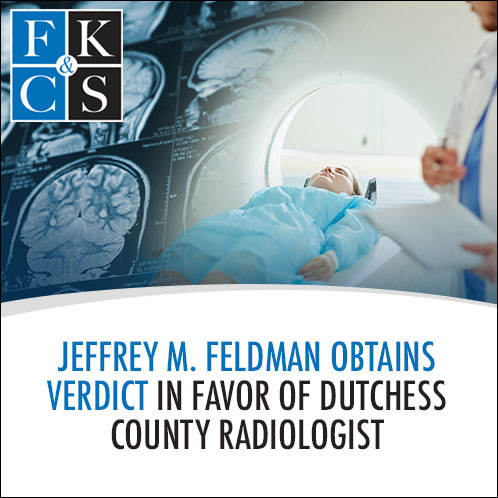 Jeffrey M. Feldman successfully defended a Dutchess County, NY radiologist in a case involving claimed brain damage of a then 19-year-old individual due to herpes encephalitis. In a very complex case, Feldman’s client interpreted a computed tomography (CT) scan of the head, ordered by an emergency department (ED) physician for chronic headaches typically suffered in the evenings. The CT scan was read as being normal.
Jeffrey M. Feldman successfully defended a Dutchess County, NY radiologist in a case involving claimed brain damage of a then 19-year-old individual due to herpes encephalitis. In a very complex case, Feldman’s client interpreted a computed tomography (CT) scan of the head, ordered by an emergency department (ED) physician for chronic headaches typically suffered in the evenings. The CT scan was read as being normal.
Subsequent to that ED visit, the plaintiff returned to Vassar Brothers Hospital in Poughkeepsie, NY about 12 hours later, having suffered from unremitting watery diarrhea since discharge from the ED earlier that day. The second ED physician diagnosed a clostridioides difficile (C. diff) infection based upon a positive PCR test. The plaintiff was admitted under the service of her primary care physician, who attended to her for the next four days. During that time period, the plaintiff began to experience focal neurologic issues, culminating in a “seizure” on the third hospital day, which ultimately led to the diagnosis and treatment of herpes simplex encephalitis (HSE). The plaintiff was transferred to a tertiary care hospital, where she underwent multiple operative procedures, and subsequently was referred to Blythedale Children’s Hospital in Valhalla, NY, where she required extensive physical, occupational and speech therapy.
The claim against Feldman, Kleidman, Collins & Sappe LLP’s (FKC&S) client was that the CT scan had an area of abnormality, which was not reported, and which mislead the subsequent treating physicians into thinking that there was no issue with the plaintiff’s brain.
The plaintiff’s neurology expert, who specializes in treatment of HSE, conceded on cross examination that CT scans can more often than not be normal during the early phase of HSE. The expert further conceded that a normal initial test (whether CT scan, MRI or lumbar puncture), must be repeated if symptoms change or evolve that are suggestive of HSE. The expert agreed that one “treats the patient not the imaging.”
Both FKC&S’s client and their neuroradiology expert explained that the CT scan was in fact normal, that the claimed abnormality was also seen in other areas of the brain not affected by HSE on subsequent studies and that the claimed “abnormality” was due to the patient’s position in the CT scan gantry (head tilt), and was seen on the opposite side of the brain in other slices.
The plaintiff’s counsel requested $10 million in damages for past and future pain and suffering and approximately $300,000 per year to cover future medical costs, in addition to about $1.2 million in past and future lost earnings.
After roughly a three-week trial and less than one hour of deliberations, the jury returned a verdict in favor of FKC&S’s client, finding that the CT scan had been properly interpreted and reported.
In discussing the verdict, Feldman said: “Though I’m the trial attorney and do the preparatory work and work in the courtroom, these cases are a total team effort. In this case, Terry Horner did a substantial amount of legal research and prepared many memos of law regarding some novel legal issues. Bain R. Loucks also prepared and submitted a motion before the trial. Patti Porcaro, who has been working with me for more than 40 years, handled many of the paralegal tasks. Thanks to this amazing teamwork, we were able to obtain the best possible result for our client.”

